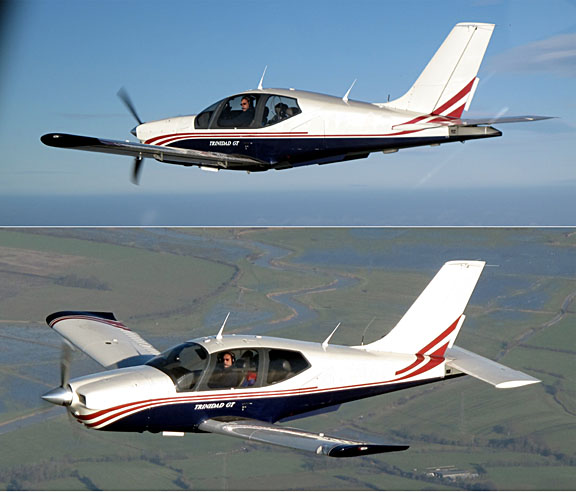
Trip to Crete - June 2010
This article describes an IFR (airways) trip from Shoreham (EGKA) to Sitia (LGST) in Crete, via Losinj (LDLO) in Croatia, and back via a small airfield in Greece, Kerkira/Corfu (LGKR) in Greece, and Zadar (LDZD) in Croatia.
All stops were chosen to be in places which we wanted to visit anyway i.e. no stops purely for fuel.
We had planned to fly to Crete via Prague (Czech Republic) but this was dropped, partly due to widespread marginal weather in N Europe, and partly due to the distance from Prague to Crete being about 1000nm which, while technically fine, is unwise due to the lack of alternates around Greece which have avgas. Possible stops enroute from Prague to Crete which were checked out were Belgrade LYBE in Serbia (feasible), Sofia LBSF in Bulgaria (very pricey), and Thessaloniki LGTS in Greece (apparently no avgas).
Procedurally, the flight was very similar to other airways flights I have done, but in flying to Crete from the UK with just one stop it demonstrates the long range capabilities of the TB20 aircraft better than I have done before. Other VFR and IFR trip reports can be found here. I had flown to Sitia in Crete previously, in 2004 and that trip - being VFR - was much more challenging.
Here is a glossary for non-aviation readers.
Aircraft
The aircraft is a 2002 Socata TB20GT which has a zero-fuel "book" range of approximately 1100nm and an economical cruise speed of 155kt TAS at 10,000ft. Extra economical cruise power settings can extend the zero-fuel range to 1300nm which, according to FAA rules, translates to approximately 1100nm with IFR reserves. It has a ceiling of about 20,000ft and is equipped with oxygen. It is not certified for flight into icing conditions but has a TKS de-iced propeller. This is the actual aircraft

Navigation equipment includes a KLN94 IFR/BRNAV GPS and a KMD550 MFD and these are used for primary navigation. IFR flight in Europe above FL095 (generally) requires BRNAV certification which in the GA context is met only with a BRNAV approved IFR GPS installation. The most common means of BRNAV compliance is one of the Garmin 430/530 products but many other panel mounted GPSs have been approved. BRNAV can also be met with the old KNS80 (with an antenna filter to meet FM Immunity regs) but this product will not alone function in today's "everything is RNAV" environment where one is routinely sent to a VOR which is a great distance away.
The aircraft has a KFC225 autopilot which can track VOR/GPS/LOC/ILS and fly a preset altitude or a preset VS. There is an additional battery powered Garmin 496 GPS which also provides an audio terrain warning (TAWS) function with a European terrain and obstacle database. The TAWS function projects the current trajectory for 2 minutes and if there is a terrain conflict, one gets a "pull up" type audio warning whose tone gradually becomes more urgent. A WX500 stormscope is also installed. One of the radios has 8.33kHz channel spacing to legalise flight at 20,000ft although I have never been assigned such a frequency
Flight Planning
The routes were planned using Flight Plan Pro (FPP) which was used to generate a Eurocontrol-accepted airways route which was then pasted into Jeppesen FliteStar from which I printed out enroute chart sections, plogs, etc. The workflow I use is illustrated in this article. There are other ways one can do this; nowadays there is enough capability in FPP alone to print out almost everything that's needed. IFR route planning is tightly constrained by the Eurocontrol system, and with flight itself being a wholly point to point RNAV button-pushing exercise, it is an interesting observation that one needs a lot less flight planning software functionality for IFR than for VFR where good and current mapping data is needed - at least that's true for piston aircraft where one is not working with a severe altitude versus fuel burn (i.e. range) tradeoff.
It always pays to do as much as possible back home, before departure, where internet is free, printing is cheap and quick, and one would not depart in any case if the weather is not suitable. For this trip, all routes were preplanned and the ones actually intended to be flown were printed on a colour laser printer. The pile of paper was about 20mm thick.
One thing which made some flights tricky was airport opening times. In Greece in particular, some airports open for just a couple of hours around a scheduled commercial flight. Croatia had a similar issue in places but has much improved.
Weather Planning
I try to use "technical" methods to make the go/no-go decision as objective as possible. In the context of flying a non-deiced aircraft (I have propeller-only TKS de-ice, which really does work very well but is no good for spending hours in icing conditions) this means establishing whether the enroute section of the flight can be done substantially in VMC, which given European airway levels means VMC on top if there is any cloud about. One therefore needs to establish where the cloud tops are likely to be. This is not trivial - some notes are here and here.
Lately I have been heavily relying on satellite IR images to get a "cloud tops METAR" just before a flight and this technique has been completely successful on every flight where I have used it.
On the first flight of this trip, the weather was difficult. In the past, I used to simply avoid frontal weather. On longer trips like this one, we would normally set aside 2-3 days for the departure, and if it looked impossible all the way through then we would get an airline flight (and probably go somewhere else). Once one is well away from the UK weather system, e.g. south of the Alps, things tend to be a lot easier. However, using such a simple policy, we would have not got out of the UK for about a week after the planned date. The first four MSLP charts 1 2 3 4 did not look good so, together with my principle of always flying on the first technically flyable day even if a following day "looks better", we got our stuff packed and looked at the actual conditions on each morning.
On the first day (10th June) the 0600 1200 1800 MSLP charts did not look promising for the first flight (EGKA-LDLO) and the 0600 1200 SigWx were of no more use, but the 0400 IR satellite image showed a lack of any clear frontal situation (suggesting that much of the high level cloud showing was just high thin layers) and the altitude-calibrated version looked similar. The radar image showed some dense cloud but the sferics image was clear. The TAFs and METARs confirmed a likely dense cloud but no high buildups. The Meteoblue data - for a change - agreed. The 0500 IR image agreed with the sferics image and importantly on the location of the very obvious thunderstorm around the border of France and Germany. Finally, I looked at some ascents (weather baloon probe data) for 0000Z and appropriately upwind of the planned route and these indicated a temperature-dewpoint spread of about 5C which is certainly not solid IMC.
So we decided to go, with a plan to turn back if solid IMC with excessively high cloud tops was encountered, either to Shoreham or, if the turnback decision was made later, to somewhere in Germany, with Dortmund being one possibility.
Equipment
On any significant trip I carry a lightweight laptop (an old 12" Thinkpad X60S-1704 with a 6 hour battery) with everything needed to do VFR and IFR route planning, get weather, notams, file flight plans, and communicate via fax and email. Not having this makes travelling by light aircraft far too much hassle. The laptop has several different ways to get internet access; in descending order of preference: wifi, a bluetooth connection to my Nokia E51 GPRS/3G phone, a USB cable connection to the same phone, a built-in GPRS/3G radio (with a T-Mobile SIM), and a USB cable connection to a Thuraya 7100 satellite phone. Fax (which remains essential for airport communications, where a phone call is difficult due to language issues) is done via email2fax and fax2email accounts; these are not free but are very cheap. I used to use Winfax for sending faxes but have not used it for a year or two; not least because it is very flakey with GSM modems... On long trips I also carry a Canon IP90 A4 printer

The printer can be battery powered but the battery pack makes it heavy, and the mains power unit has to be carried anyway in case the battery goes flat. The printer may seem "excessive" but is brilliant for printing out enroute charts and approach plates when one has to substantially replan something. The alternative is to print to a PDF, copy it to a USB stick, and look for an internet cafe or a printing bureau which can print off the PDF .... hopefully in colour. I find it suprising that nobody today makes a compact lightweight A5 printer. There are some A6 printers but that is too small to read, for most people over 45...
Given the nature of IFR planning, a loss or failure of the laptop would be extremely inconvenient, so on long trips I also carry a cheap little Asus EEE 901 laptop which has almost the same software configuration as the main laptop. This backup laptop stays permanently in the back of the aircraft. It is slow and its small keyboard is hard to use, but it is a whole lot better than nothing. On short (overnight) trips, on which everything has been pre-planned, pre-filed, and pre-printed back home, and there is very little chance of anything going wrong, I tend to carry this laptop as the only one because it is easy to chuck it into a backpack.
It is tempting to go fully "electronic" in the cockpit: print everything off to PDFs, and transfer these to something like the Kindle DX e-book reader, or the Apple Ipad. This would eliminate all printing. The Ipad, with an aftermarket matt stick-on screen filter, makes a particularly competent PDF viewer providing there is no direct sunlight. The data transfer method would depend on whether the document viewer is to hand when planning, or remains in the aircraft. None of the options are particularly robust. The Marketing Dept's choice - emailing the data to oneself and then downloading it on the reader using GPRS/3G - is the least attractive, given the multi-megabyte data size and the vagaries of roaming GSM in some places. The biggest issue is: what if it fails? Anything electronic can fail; even the data transfer can break, but paper printouts can't. One would need a 2nd (backup) document reader. I currently run the competent if outdated LS800 tablet (see further below - original cost over £2200, in 2005) whose broad WinXP functionality cannot be replaced with any closed-architecture product such as the Ipad or the Kindle. A more modern WinXP tablet is the Viliv X70EX (around £600); I have tested this and it is OK but like all "consumer" LCD products (including the Ipad) it falls down on sunlight readability - more pics here. The Sumo 312 is a more serious product, at about £2200 with all the required options. Going shopping for gadgets is fun but the reality is that paper is easy to read, easy to organise into the expected order, costs almost nothing, needs no backups, and just carries on working... I waste a significant amount of my working day getting gadgets to do exactly what I need, and fixing them when they have other ideas. The issue of totally unplanned in-flight diversions remains, but this rare situation is addressed adequately with a single device storing a wide choice of approach plates. In an emergency, once can fly a radar vectored ILS knowing just the frequency and the runway heading.
I always fly with a liferaft, an emergency bag containing a 406MHz EPIRB, a handheld radio and a lot of other stuff, a second 406MHz+GPS EPIRB, and together with the large 48 cu. ft. carbon/kevlar oxygen cylinder these take up the RH back seat. There is also a large toolbox with enough tools to do the 50-hr service plus potential emergency jobs like changing the vacuum pump. On longer trips such as this I also carry a complete set of three spare servos for the notoriously unreliable KFC225 autopilot, a second identical oxygen cylinder and a spare 1st stage regulator, 1 refill for the 2-litre TKS propeller de-ice system, and several 1-litre bottles of isopropyl alcohol (IPA) for use as fuel anti-icing additive (there is no known case of a TB20 suffering fuel icing but this is a very cheap precaution). Plus four 1qt bottles of engine oil. Plus a lightweight reflective aircraft cover (from Bruce's Custom Covers) which keeps the cockpit cool when parked in hot climates and is a huge help in keeping the interior in good condition. It is difficult to imagine doing such a trip in one of the many 2-seater "homebuilt/sports" types. This leaves the LH back seat free and Justine sometimes likes to sit there; the rear seat is a lot thicker and softer than the front ones; in that case I run down the LH fuel tank substantially, to keep the aircraft balanced.
The route illustrations in this article are screenshots from Jeppesen FliteStar IFR. The terrain profiles shown at the bottom are not usable for safety altitude planning; in fact the Jeppesen data contains systematic errors. The vertical profile of an IFR flight is at a minimum level which is decided by what is acceptable to the Eurocontrol computer. The minimum levels which can be filed tend to be around FL070 but acceptable routings usually need higher levels. Sensible routings start to appear around FL100 and the best ones (below FL200) are obtained at FL140-FL160. Oxygen is therefore highly desirable for European IFR.
Flight Shoreham-Losinj
Route:
EGKA
MAY M140 DVR L9 KONAN L607 RUDUS L984 ASKIK Z74 AKONI L603 OLETU Z106 BAVAX
M867 NOKDA Q100 ARNOS P125 URAVA L607 ILB P81 CRE
LDLO
FL150 Distance 700nm (GC) 779nm (airways)
The flight plan was filed about 1 hour before departure, using AFPEx. With IFR flights - particularly ones to the east - there is a risk of a departure slot being issued by Eurocontrol. For GA flights in the FL100-180 band, these slots are apparently meaningless artefacts of their software and in any case the resulting delay tends to shrink near the time due to the slot time being modified, so one must still be ready for a departure at the originally filed time. On this occassion, due to the Shoreham tower being unmanned 0800-0900 local time, and with AFPEx not supporting incoming message forwarding to SMS (there is no practical way to run the AFPEx Java client application on a portable device, though there are obscure "remote desktop" solutions) there was no way to find out about a Eurocontrol slot. Homebriefing does offer SMS notifications, but I stopped subscribing in 2009 because there are now at least two other free ways to file IFR flight plans and I don't need to pay 40 euros/year for a third method. So I phoned the ever helpful AFPEx helpdesk and checked... and there were no slots.
If doing this type of "farm strip" departure, one contacts London Information on 124.60 when airborne. They issued a squawk of 0027 with a "remain outside controlled airspace" instruction. The base of controlled airspace in the area is FL055. After a few minutes we were given a squawk of 0371 and handed over to London Control on 120.175, who asked for a squawk ident and then gave us a "direct DVR climb FL100", and off we went as usual in IFR flight.
The cloudbase at Shoreham was about 800ft. Cloud tops were found around FL070, with a mainly blue sky above
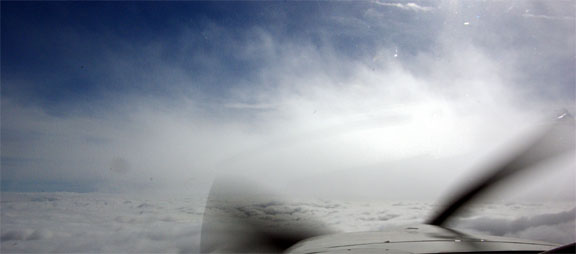
The surface temperature was around +14C, and the lowest temperature seen in the cloud was +3C so icing was never an issue, but one would not be expecting much ice in such smooth stratus. The haze improved as we climbed
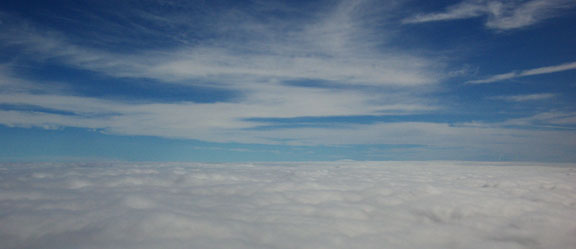
There was plenty of high but thin cloud around which no doubt featured prominently in the IR satellite images. It was obvious - yet again - that the best data for making the final go/no-go decision is the actual data: satellite IR images, and weather probe ascents. The forecasts, SigWx included, were basically rubbish.
Due to the very good conditions and to conserve oxygen, I asked for a stop climb at FL100. London Control offered FL090; apparently this level was requested by the next sector. Upon a handover to Brussels we were cleared KOK LNO GELPA which in one clearance took us right across Belgium and into Germany.
The cloud tops started to rise; I requested FL100. This is not on the official semicircular levels (odd numbers if going east) but normally ATC do not care about these. I don't know if Belgium has changed its policy on this but they offered FL110. Soon this was not enough and we climbed to FL130
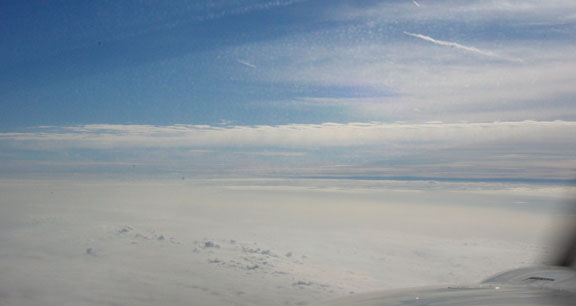
The clouds were in several layers and it might have been tempting to just fly between these, but this can be a trap: if the layers merge together, the resulting cloud above could turn out to be too thick to climb up through without a big risk of icing. So the smart strategy is to always stay on top. Self evidently very thin layers and haze can be ignored, and anyway there is little choice if these are at FL300! As a result, we had climbed to FL150 before leaving Belgium, and this was soon followed by climbs to FL170 and FL180
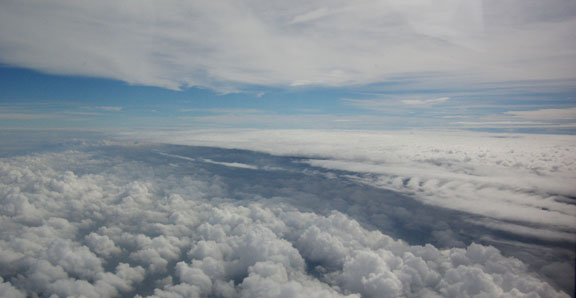
The temperature at FL180 was -8C which is substantially warmer than the standard atmosphere, but the aircraft performance was still reasonable: 95kt IAS at 9.0GPH (US), 2575RPM. The MP was 14.5" and without a turbo there isn't much one can do about that...
With enough "stuff" for a 2-week holiday, the back of the aircraft was full
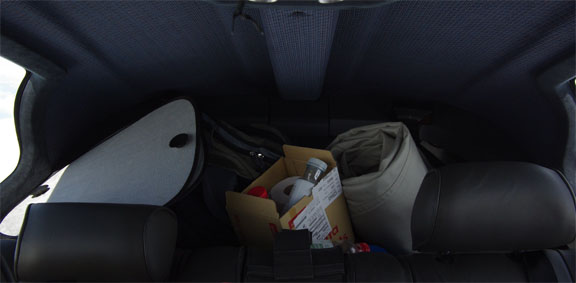
and even with two below average weight persons was about 6% below its 1400kg MTOW.
Early on in the flight, the computed landing fuel on board (LFOB) figure stabilised around 25USG and stayed that way till the destination

Munich requested a descent to FL170 which I accepted because the tops were slightly lower by then. This was apparently due to jet traffic behind us at FL180; we eventually spotted it, on a parallel track a good number of miles to our left. Here is the airport from FL170 or so:
There was a lot of haze which can be only partly removed with Photoshop, and has to be done in several manual steps because the automatic colour correction function is too primitive. In addition, during this flight the camera was accidentally set to ISO400 so the pictures are not as good as they could be.
On all long flights I run the European VFR charts as a GPS moving map under Oziexplorer, mainly for emergency use but also for identifying interesting objects on the ground
Oziexplorer was originally developed for vehicle applications in the Australian outback but it is really just a GPS moving map application which can run almost any graphical image (that can be georeferenced) as a moving map. The LS800 tablet computer used here is an outdated product but remains one of the few tablets which is truly sunlight readable. It has been modified with a solid state hard drive; the original one used to crash around FL130. It is also used to display weather data using an internet connection with a satellite phone
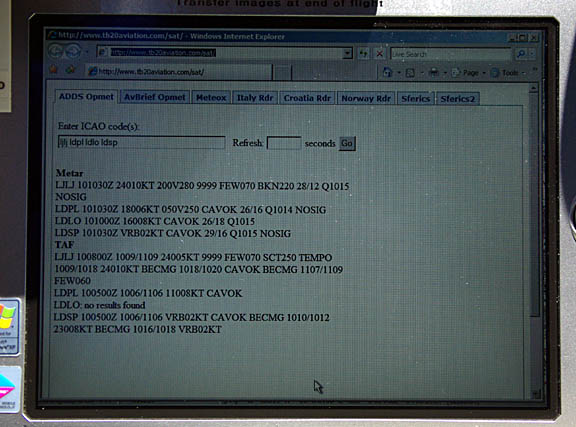
Each weather check like the one above costs about $1, using a Thuraya 7100 PAYG phone, connecting on a 1722 dial-up call at 9600 baud. The system is a long way from being 100% reliable (I don't think Thuraya care much for the reliability of their data service) but usually works fine in the context of a flight lasting several hours. One can supposedly get destination weather from ATC but many ATCOs are too busy, and some evidently don't like doing it anyway. It also appears unprofessional when the vast majority of the players in the IFR airspace (airlines) can get weather via their own comms systems (ACARS). I did some tests on using satelline phones for aviation weather - here.
The route passes near the famous Schloss Herrenchiemsee Castle, seen here from about FL170 and through a lot of haze
The winds aloft forecast bore no relation to the headwind (5-15kt) which was present along the entire route.
Around Munich, the Alps became visible in the haze
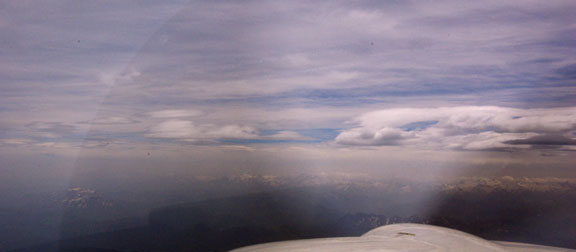
The wind was about 10kt and flowing across the Alps. A very rough rule is that for every 10kt of wind flowing across mountain ridges, one should be at least 1000ft above the terrain in order to limit the up/downdraughts to 500fpm. In this case, we were about 8000ft above most of the terrain, but there was a noticeable level of turbulence for the first 50nm or so of the Alps crossing, which then died down.
On clear days, the terrain is always spectacular
which was welcome since the last several flights I have done across the Alps were mostly above a solid overcast. At FL180, the terrain is mostly about 10,000ft below... it appears much closer!
Immediately after the Alps comes Slovenia and then the Croatian islands appear
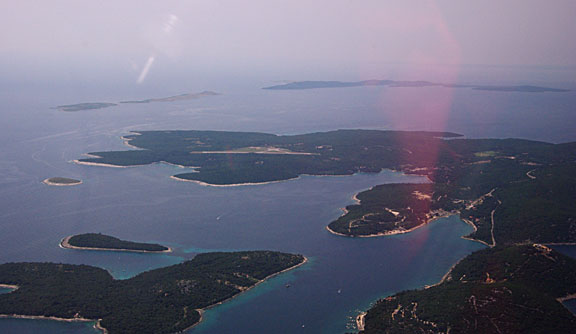
With about 100nm to run, and from FL170, I requested a descent to FL150; the objective being a continuous descent all the way to Losinj. This worked out fine, and Pula Radar issued further descents to 9000, 5000 and 3000ft.
The filed route terminates at CRE (Cres Island) and this identifies the CRE2C standard arrival. The full instrument procedure was requested and flown for practice. CRE2C transitions to the NDB circling approach, and runway 20 involves a right base turn to final. This pic was taken just before establishing on the 303 inbound track
and this is from right base; it has been cropped and this suggests we were much closer to the runway than in reality
This flight could not have been done VFR on the day, due to low cloudbases. An IMC Rated pilot could have left the UK VFR, climbing VMC on top somewhere past DVR, and then flown VMC on top to somewhere in southern Germany, where he would have got into some issues with controlled airspace, trying to remain above the cloud. Of course, a pilot who doesn't mind flying "VFR" in IMC would have been fine but could have faced some icing issues...
Losinj is a small but superbly organised place to which every European anally-retarded empire-building airport manager should have a mandatory annual visit. The aircraft is processed immediately. A single policeman makes it an "international airport" with a Customs presence. No sign of the yellow jacket brigade! The one thing one does need to watch out for are the opening hours, which can be tight for a direct flight from the UK, but are a lot better than on my last visit in 2007.
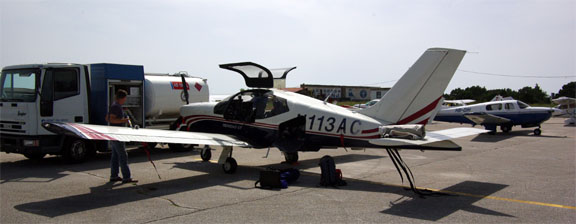
In line with the standard practice of always refilling immediately after arrival (to avoid departure delays) we refuelled right away. In a warm place, this has the drawback that one is likely to lose anything up to a gallon of fuel (approx 1% of the fuel tank content) to evaporation and fuel loss through the expansion vents as the tanks warm up, but is still worth doing. And anyway one can always top the tanks off before departure, if it appears this can be done without delays. Evidently, Croatia has realised that it was selling avgas too cheap and the price is now fully at EU levels, having increased by about 2x since 2007.
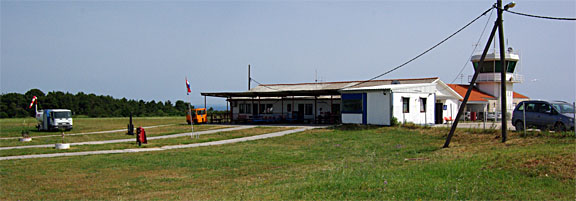
We landed about 1hr before the closing time, and a number of aircraft (mostly German) departed shortly afterwards
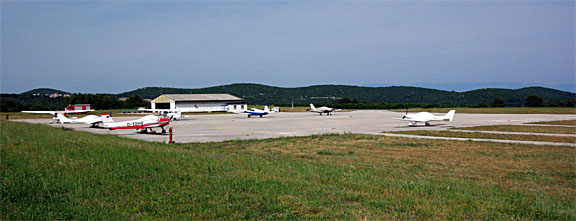
Each parking position has a couple of tie-down rings embedded in the concrete.
There is a super little cafe
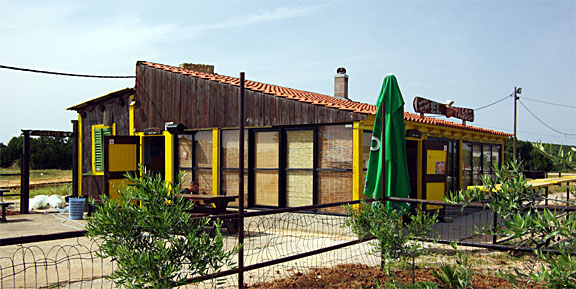
and then it's time to get a taxi into town; Mali Losinj is the biggest, with a population of about 6500
Losinj
We checked into Hotel Apoksiomen for 3 nights. The hotel was very nice (we stayed there before in 2007) but the air conditioning turned out to be not working, which made sleeping very difficult; this was reported 3 times before the next morning but with no evident action. On the second day a different person revealed that the whole hotel had this problem, and would not be fixed for several days. It was pretty obvious that they knew this all along... Given the +35C outside temperature and the need to get a decent sleep, we relocated into a really nice small hotel; Mare Mare. I would highly recommend it. Unfortunately for us they had a room for 1 night only, so we spent the three nights in 3 different places.
Losinj is a truly lovely island; unspoilt by mass tourism. One can imagine life here has not changed for decades. The locals are very friendly and the food is excellent.
Justine's Highlights
Step out of the plane and smell the wild herbs. Almost every plant on the island seems to be aromatic (our guidebook says there are 250 types of herb here).
Have a drink at the airport's funky El Paso bar, the perfect place to get your stuff organised, text the folks back home, break into your nice new 200 Kuna notes and call a taxi (if the driver doesn't show up anyway - word travels fast here).
The nicest place to stay in Mali Lošinj is the Mare Mare Suites, a sort-of boutique B&B with a jacuzzi deck and very friendly staff. A little way outside are the resort hotels of Cikat, which look worth a try if you want to be close to the swimming spots. Book in advance if you can as there's no central agency and finding accommodation at short notice can be difficult and time-consuming.
The bus trip to Cres is a great day out if you don't mind a slightly deranged driver and a vehicle with almost no suspension. We were literally bounced out of our seats every time the road got bumpy.
Look out for sea urchins - the sea floor is very rocky and the spiny wretches
are everywhere. Bring or buy a pair of watershoes or you'll be landlocked.
Flight Losinj-Sitia
Route:
LDLO
EBITA N606 ZDA L607 DBK R45 TAZ W47 POD L604 RETRA Y400 MAVAR N132 TALAS B1
ATV L617 XAVIS
LGST
FL150 Distance 776nm (GC) 820nm (airways)
In the morning, the TAFs and METARs showed nothing of significance. The MSLP charts 0600 1200 were clean, though they would probably not reveal the potential for thunderstorm formation - another reason to do the flight early in the day. The sferics image was clean. The satellite IR image showed some high altitude cloud tops along the Croatian coast.
The relevant Sitia opening hours on the day were 1230-1430 UTC and a flight time of approximately 5:30-6:00 was expected. So we planned to get airborne 0600 UTC.
On the day of departure, Losinj airport was quite busy, with a queue of tourists waiting for a Dash-8 twin turboprop going to Innsbruck, and looking very envious of the GA pilots who were departing on their own timetable. The police however processed GA separately, and we were done in about 30 mins. A rare Extra 500 turboprop was seen
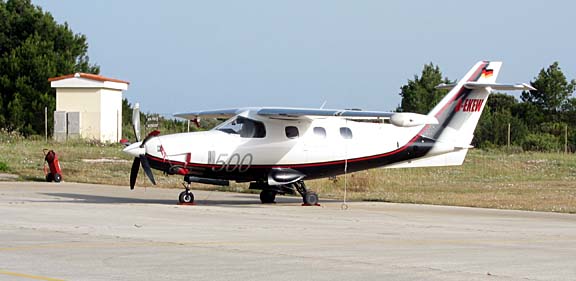
As expected, there was a certain amount of fuel loss due to the wing tanks warming to the ambient over the three days and excess fuel spilling out through the overflow vents. The loss was about 20mm below the "full" level which is the brim of the filler hole. This seems to be the usual amount, and measurements show it is worth about 4.5 litres (1USG), so I set the departure FOB on the fuel totaliser to 85.0 instead of the usual 86.2USG.
On this occassion the flight was filed using EuroFPL. This excellent new IFR flight plan filing site also provides a flight tracking facility, which was useful as I was going to meet a few people at the destination.
Given the runway 20 and the first waypoint of the filed route of EBITA, the expected departure was EBI2D and sure enough this was it. The initial IFR clearance was direct LGST, FL130. The flight was completely straightfoward. Curiously, the original squawk of 6546 was changed twice during the flight; to 4017 by Zadar and later to 7033 by Athens. This perhaps explained why the EuroFPL tracking facility did not pick up the aircraft progress until about halfway. The 70xx squawk looked suspicious (70xx is VFR in much of Europe, and you don't ever want to get your IFR clearance accidentally terminated) but Athens confirmed we were an IFR flight.
The departure passes alongside the town of Mali Losinj where we had stayed
The visibility was about 10nm which, at FL130, meant one could not see much except when looking straight down
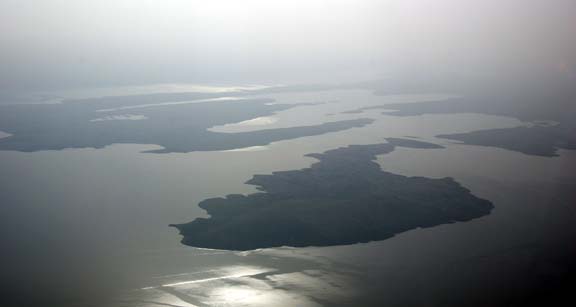
Here is Brac airport - another lovely island well worth a visit, with a superbly organised airport with Customs and avgas. I have been there before 1 2.
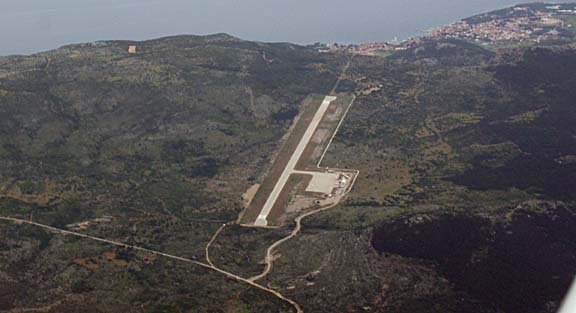
Most of the cloud along Croatia turned out to be harmless thin stuff around FL160 but there was one bit which went down to FL120, was darker, and had some rain falling out of it. Since the OAT was just +1C and would be bound to fall inside the cloud, we descended to FL110, and climbed back to FL130 afterwards to remain well above the mountains of Albania where some turbulence might have been expected.
There was a thin layer of cloud above but getting above it would have needed about FL180 and there wasn't any point
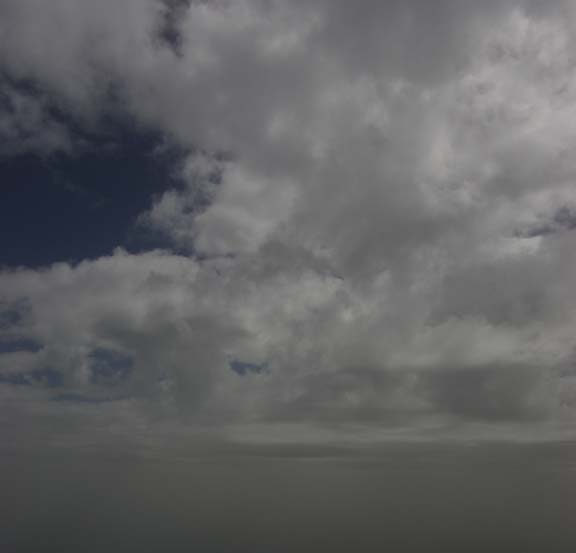
The end of the known universe becomes apparent when the coverage of the only current aviation charts ends at the end of Croatia...
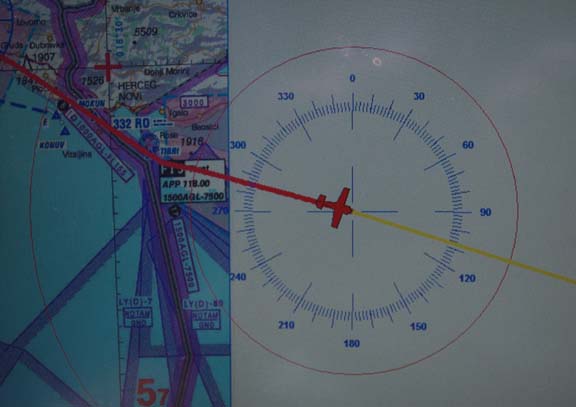
Fortunately not only are VFR charts not practically required for IFR (except in special situations like Z or Y plans, or some emergency) but also there are the old (1990s) U.S. ONC/TPC charts which are easily obtained for use as a GPS moving map, and I have them for all relevant areas; these are out of date but the terrain doesn't change much...
Not much was seen of Albania
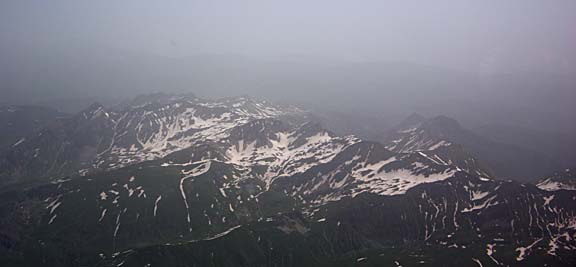
but there must have been a huge amount of snow on those mountains during the winter, since we were flying in June at +2C and these peaks were about 6000ft below us.
The LFOB figure had hovered around 25-28USG for the first part of the trip

Initially we had a headwind of about 5kt but this later changed to an increasing tailwind, which eventually reached about 25kt. For fun, I replaced (in the GPS) the destination of Sitia LGST with Cairo (HECA), to see how much fuel we would have landed with assuming the ground speed had been maintained... 9USG!
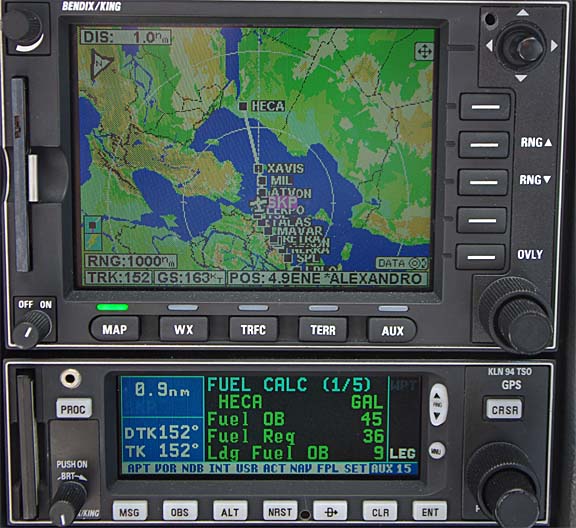
Given the prevailing NW winds, a TB20 could quite often fly from Shoreham to Crete nonstop, albeit with a reckless reserve. Shoreham to Corfu is completely doable but all the alternates would not have avgas; getting a 200 litre drum shipped to a Greek island would cost a small fortune.
There seems to be an increasing amount of co-operation between some countries in this "politically difficult" region, because Skopje Radar gave us a 142NM DCT right across FYR Macedonia, all the way to Thessaloniki.
This is an Olympic stadium at Athens
On this day, Sitia was open for just 2 hours, and the departure time was originally planned for an arrival 30 mins after it opens. Due to the tailwind, the continuously re-computed ETA wound itself back until we were looking at arriving before the opening time. I reduced the power by going further into the LOP region, too keep the ETA within limits. The fuel flow was just 8.6GPH for a TAS of 133kt.
The Greek islands can have strong winds. For some reason, my satellite phone did not work and Greek ATC would not obtain the Sitia weather despite my 2 requests being met with "standby". I eventually got it from a much more helpful controller at Iraklion; it turned out to be a non-issue but was anyway too late for an efficient diversion. The weather for Sitia (LGST) is not available via most popular weather websites; from NOAA you get nothing, from Avbrief you get the TAF but no METAR, but this site carries it.
Here is Santorini from FL130 - another nice place to visit, which we did VFR in 2005
We did not see Crete until quite late, due to the haze
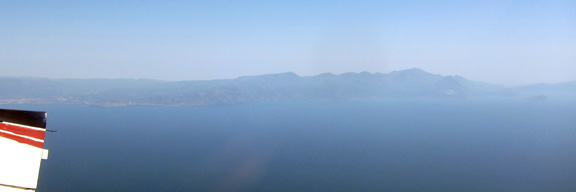
I flew the full arrival and VOR approach procedures. The DME arc took up another 5 minutes... Here is the final approach to the vast runway
This flight could have been done VFR, at some suitable level below the clouds, without any problem, though the route would most likely have been different around the Montenegro/Albania airspaces; see my 2004 and 2005 trip writeups.
The tower is "Information" not ATC, so no landing clearance is issued; you land at your discretion. Sitia airport is just as sleepy as it was on our last visit in 2004, and with the same warm welcome in the tower by the same Mr Dimitris
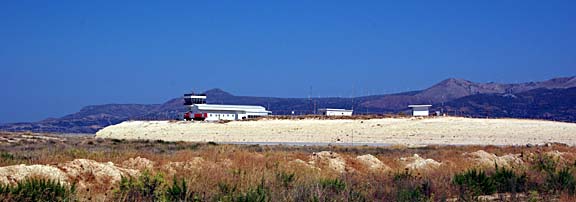
Due to the non-EU arrival (which required a 24hr PPR for Customs) we had to fill in a GENDEC form which took all of a few minutes, and that was it... very unlike every other Greek airport I have been to, where form filling can be extensive.
The fuel storage method has not changed since our last visit in 2004 and the cupboard on the right contains the pump
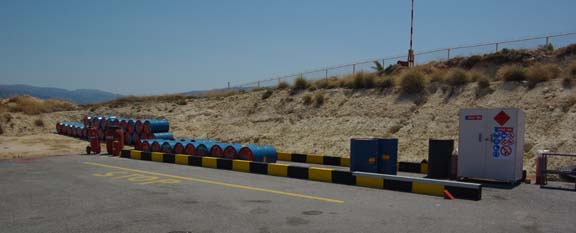
The landing FOB was 29.2USG and the refill was within 1% of the flowmeter-computed figure.
The fuel facility is near the tower but longer term GA parking in on a vast apron on the north side of the runway
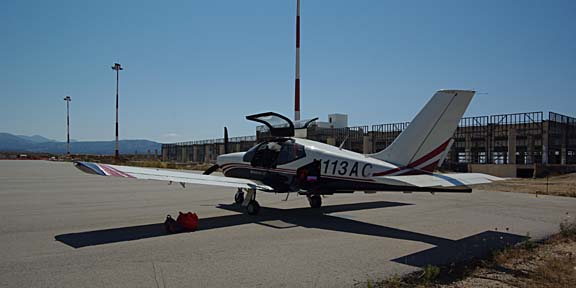
which was totally empty and where a huge passenger terminal - about 10x bigger than required for any remotely conceivable level of passenger traffic for this part of Crete - is under construction ... apparently it has been under construction for several years now, and I don't really think there is a big hurry to finish it, which is bound to be good news for GA. Sitia is a superb facility and quite unlike the vast majority of airports in the area, most of which specialise in job creation and paperwork generation. It is a Port of Entry which is very handy for flights to e.g. Israel or Egypt, and needs 24hrs PPR for a non-EU arrival or departure. An Aegean Airlines AVRO RJ100 (BAE146-lookalike) turned up while we were waiting for the taxi to parking, which shows how GA can co-exist with the big stuff perfectly.
Sitia
As we found on our visit in 2004, Eastern Crete is much quieter than the other parts. Sitia is a lovely town with a harbour, a sandy beach and lots of cafes
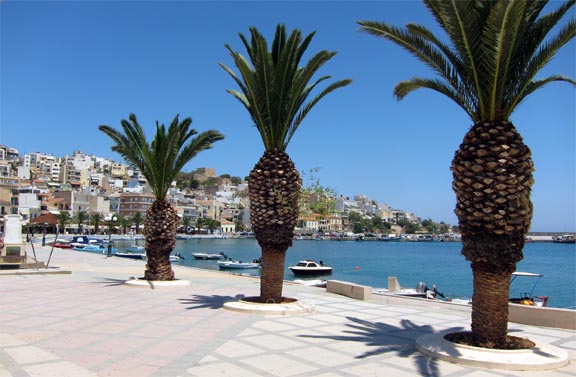
We stayed in the Sitia Beach Hotel which was excellent... apart from pricey internet access in the rooms. Internet was free in the lobby downstairs when it worked, which was not very often... back to GPRS/3G as usual.
Alongside stunning landscapes

there is much to see in eastern Crete. It is a laid back part of the island; much less hectic than the middle or western parts (Iraklion and Hania). The lack of traffic is astonishing.
We did a 1hr boat trip to Chrissi Island (also known as Donkey Island) which is nearly Europe's most southerly point. Gavdhos Island is the most southerly but is much less accessible. Chrissi is a lovely quiet place with one bar with sandy beaches all round
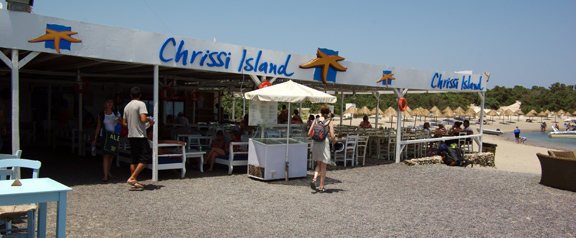
and some people camp out among the sand dunes
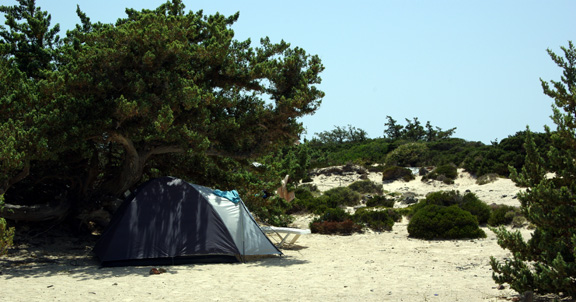
The island seems to have a few permanent residents who are seen at the bar...
Property prices in Crete are more or less at UK levels and - unlike e.g. Spain - development appears to have been reasonably well controlled. There are just a few odd examples e.g. this huge self contained estate across the bay from Sitia, with a guarded gate

which after years remains almost entirely empty, and this very old unfinished hotel

with, presumably, the workers' tombs alongside....
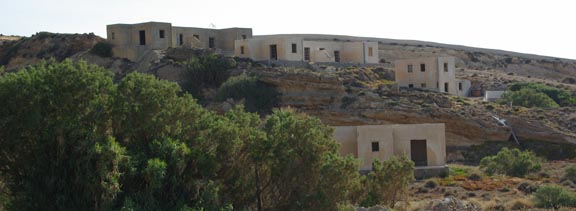
There are more unfinished developments on the southern coast though. I would be astonished if the vast Sitia airport terminal was ever finished, too.
During our stay in Crete the daytime temperature was around +35C and getting hotter... It was satisfying to notice the IR image showing a totally unflyable band of frontal weather stretching from Portugal to the Black Sea (MSLP) but unfortunately this weather caused the massive flooding in France.
Justine's Highlights
Top marks to local food, food and more food - tangy Cretan cheese, fish
caught the same day, aromatic little olives, succulent stuffed tomatoes, and
a real charcoal grill in every tiny taverna.
Toplou monastery is a short ride from town and definitely worth a visit if you
have transport. It has an astonishing collection of icons and early engravings,
and a well stocked shop where you can invest in a replica if you like that kind
of thing. The monastery wines are excellent too and you can buy them in any
supermarket.
East of Sitia see if you can spot the bizarre monstrosity that is Dionysis Village - a tightly corralled high-density urban development transplanted onto coastal countryside, now unsurprisingly unoccupied. How did they get permission to build such an eyesore?
If you travel in June like us, you'll see purple flowering thyme on every hillside - the origin of famous Cretan thyme honey and no doubt also the fragrant local lamb.
Visit the beach at Vai for golden sand with the added attraction of Europe's only native wild date palms. Park in the further car park (with the buses) to avoid the EUR3.50 charge just down the road. Be prepared to pay top dollar for everything else here though.
If you get to Ierápetra on the south coast do a day trip to Chrisi Island (aka Galdouronisi) - the closest thing to an unspoiled desert island. Sleeping here must be amazing - next time I am bringing a tent and spending the night.
Flight Sitia-Mesolonghi-Corfu
Normally, it would be difficult to fly from Sitia to the UK in just two legs, because one would expect a headwind on both of them. Picking very pleasant stops with efficient airports, one would fly Sitia - Dubrovnik - Losinj - UK or something like that. On this trip, however, we were meeting up with a group of Greek pilots at an unmanned municipal airfield called Mesolonghi (under the MESSI intersection on the map below). This in turn meant that a further stop would be required to clear Customs (Greece has signed Schengen but disregards it if a vehicle is involved) and the only option in the area with avgas is Kerkira (Corfu) LGKR. There are other Customs-only options, e.g. Kefalonia but - having last fuelled at Sitia - those would mean an early stop in Croatia, which would in turn mean two more stops before the UK. And we had arranged to meet another friend in Corfu...
Route:
LGST
VEGES L613 ALANI A14 ARA VFR DCT MESSI (Y flight plan)
Mesolonghi
FL100 Distance 291nm (GC) 311nm (airways)
Mesolonghi
MESSI DCT GARTA/N0150F080 IFR (Z flight plan)
LGKR
FL100 Distance 104nm (GC) 106nm (airways)
This airfield has no ICAO code so the flight plan is filed as ZZZZ and a DEST/ or DEP/ MESSOLOGI is added to the Remarks section.
The weather for the flight from Sitia was clear and with the IR and sferics images also clear. The MSLP chart showed a trough lying to the north of the destination. In reality, isolated thunderstorms could be expected anywhere in the region, but clearly there was no IMC around in which they could hide.
Kerkira LGKR can be problematic because of their 48-hour PPR by notam which is strictly enforced to the point of refusing a landing unless an emergency is declared. Occassionally they even notam a ban on LGKR being filed as an alternate. All this is pointless because the place is not particularly busy and has a vast amount of unused parking. Unfortunately the other western Greek airfields have no avgas... The email address specified in the notam was invalid and bounced back, but the fax number worked fine, during office hours. I had earlier tried to get a permission for a range of dates but this was refused. I think that if Kefalonia gets avgas but doesn't implement this PPR policy, GA activity at LGKR will dry up fast.
Given the initial waypoint of VEGES, the appropriate SID for Sitia is here which goes out quite a bit over the sea to allow for obstacle clearance.
Sitia is a "paradise" among Greek airports, with a lack of formalities. We already had fuel and the flight plan had been filed, so we went straight through. A part of the vast apron was being used for training police motorcyclists but they packed up just as we prepared to depart.
Curiously, the waypoint MESSI was not in the KLN94 GPS database, even though it is in FliteStar, and both of these come from the same company: Jeppesen.
The initial departure clearance was to VEGES as expected but very soon we got a series of vast shortcuts; initially from Iraklion and later from Athens Radar. The longest one was DCT TRL of 172nm.
The weather started off just plain hazy but soon we saw some massive buildups

which looked about 50nm away but actually they were much further. We climbed from the initial FL100 to FL160 to stay above the haze to maximise forward visibility. Eventually we got close
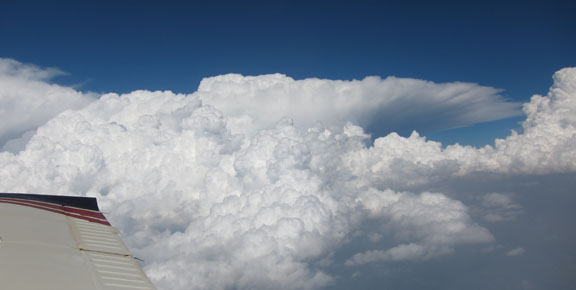
and it became apparent that they were almost over our destination. This is the stormscope display near the end of the flight
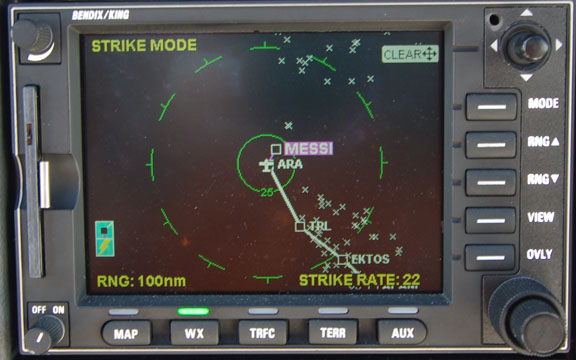
It was interesting to note that the stormscope was accurate in both azimuth (which is normal) and the distance (which is unusual). However, it was obvious that the buildups were all over the land and since Mesolonghi could be easily approached from over the sea, this was not a problem.
Athens could not believe we were landing at Mesolonghi; they asked whether we were a helicopter. I replied that there is an airfield there and has been there for some years. Eventually they seemed to accept this and then they started to press as to when I would be cancelling IFR. After a while they stated that I cannot land at Mesolonghi unless I cancel IFR.... well, this was quite true and in any case the flight plan was a Y plan i.e. IFR to VFR. So I cancelled IFR while still descending through FL140. We spoke briefly to Araxos and Andravida (both military airports) neither of which appeared to have radar available to the civilian controllers, and were asking for position reports. The rest of the flight was uneventful, except that it took a little while to find the airfield...
When flying the circuit, the Garmin-496-based GPWS system was emitting terrain warnings - unsuprisingly given the lack of the airfield in the database, and the surrounding terrain
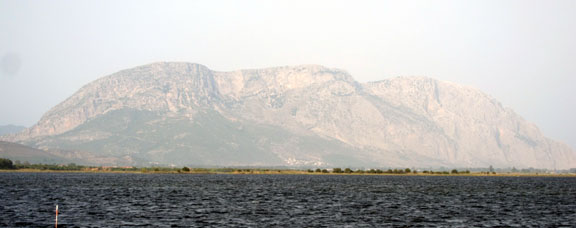
After landing, one needs to telephone the regional FIS unit to close the flight plan
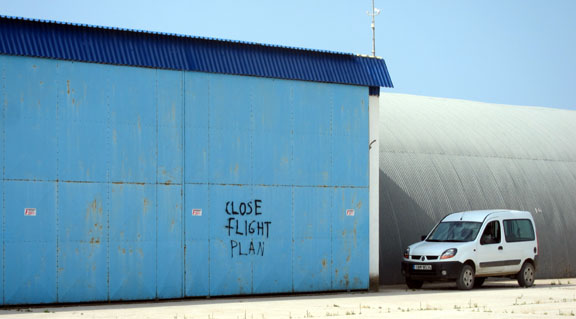
There was a Piper Lance parked
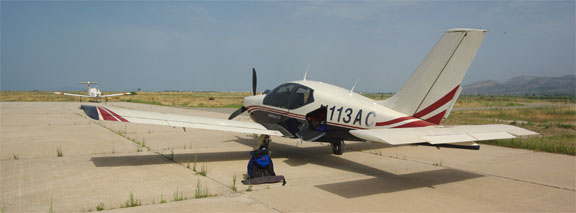
and two of my Greek pilot friends made it in a TB20 from Athens despite the worsening weather

As a post-mortem on the CBs, this is the 1500Z IR image which clearly shows the high cloud tops, and here is a slightly later sferics image showing activity in the right place.
Mesolonghi produces most of the salt for Greece, in vast salt pans
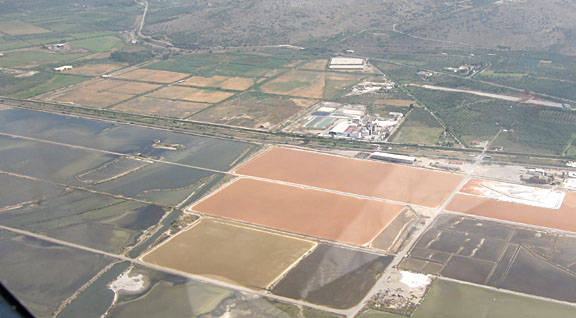
Mesolonghi airfield is unmanned and is effectively open 24/7. In practice this means daylight hours because there are no lights. The tafs and metars looked OK, with a chance of stormy weather. The sferics image showed a bit of this but past Corfu and the IR image confirmed this. The MSLP chart showed the end of a trough to the north.
The procedure at Mesolonghi is to call up Araxos when airborne to pick up the IFR clearance but there was no response; same from Andravida. This was completely unacceptable. Legally, one is outside controlled airspace and must remain thus until a clearance to enter it is obtained. If one cannot be obtained, the only safe way to fly to Corfu below controlled airspace would be to follow the coast all the way. Greece does not publish VFR charts; some diagrams of the Athens TMA can be found in its AIP (which is not online and must be purchased in paper form from the HCAA) and Greek pilots fly with the most recent (1998) U.S. ONC chart which does not show controlled airspace. According to FliteStar data, the airfield in under the Andravida TMA whose base is 1000ft AGL and there is always some "useful ambiguity" as to what "AGL" means in practice when one is flying over varying-height terrain. I was ready to try Athens, but eventually I got a response from Araxos which transferred me to Aktio who finally dealt with it by issuing a DCT GARTA FL100. No squawk was ever issued by anybody so the flight proceeded with 7000. I did say the flight was filed India-Foxtrot-Romeo but they didn't seem to understand. In retrospect I am not sure that, in addition to the lack of response to the initial radio calls, the flight plan was even visible to ATC.
I think there is a lesson here: given this is a VFR airfield, I should have worked out a plan on what exactly to do if I cannot get any radio contact after departure. In the UK, not being able to call up "somebody" is not something one ever plans for. In this case, the only option would have been to fly below 1000ft AGL all the way to Corfu, which given the poor visibility due to haze means flying at 1000ft QNH along the coast. However, if this was inland, with some terrain around, one's only option would have been to turn back and land. Another thing is that Z or Y flight plans need to be sent not just to IFPS (the default) but to any airfields who will be called up on the radio to facilitate the IFR clearance. IFR flight plans get delivered (by IFPS) only to departure, destination, and the area control units.
We were transferred to Corfu (the airport and the city are called Kerkira) early; with about 60nm to run, and they issued a descent to 2500ft. For an IFR flight this would have been completely out of order, given terrain below and ahead rising to 2x to 3x this altitude!! Such a clearance was obviously below the controller's MVA. It would have easily killed a pilot who was under the impression of having an IFR clearance, a radar service, and - as is routine in IFR - was not terrain-aware. Perhaps Kerkira had not connected up the flight with the filed IFR flight plan, and thought we were VFR? I had made it clear to earlier stations that this was a filed IFR flight, but I don't think the military controllers are connected into the IFR enroute system, or even talk to each other much. I descended nice and slow, and later Kerkira amended the clearance to be at 2500ft by KRK which was still some 35nm ahead, so this was done as a continuous descent. Later were were asked to descend to 1000ft as for a VFR flight, for a left hand circuit to runway 17
so presumably Kerkira ATC thought were were VFR all along, and maybe the IFR flight plan got lost in the system...
Sitia to Mesologhi Picture Gallery
We were number two behind a 737 which was landing on a straight-in approach and ATC said the runway would be clear in 3 minutes. As we were already downwind, I offered to do a right orbit. A different controller replied with an affirmative. Halfway through the orbit they cleared us to land so I turned back to do a left base, getting a good pic of the castle
and here we go...
One gets a follow-me vehicle to the parking spot
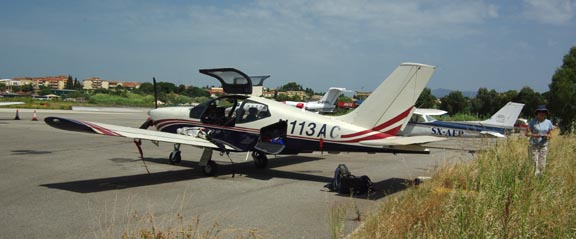
The Olympic Handling van turned up within a minute; avgas was requested and turned up a few minutes later. The Olympic Handling costs were 17 euros and we paid those immediately inside the terminal. All in all, very efficient and much quicker than on our past visits. However, as before, the CAA fees are paid separately at an airside office to which one needs to be escorted and these fees cannot be paid until the day of departure.
The landing FOB was 43.2USG and assuming a fill of 85USG at Sitia due to fuel loss (max usable is 86.2) the 170 litre fill at Kerkira represents an error within 1%. This was the first airport encountered in 2010 which accepted the AIR BP card. I try to use the card when I can, in case I need it one day. I got it around 2002; back then airport payment terms were sometimes weird (e.g. cash or Mastercard but not Visa, and the cash machine was broken - Mikonos LGMK) but nowadays they all seem to be better organised and accept Visa. The one known exception in Europe is the French TOTAL fuel card which is the only means of payment in the self service machines at some smaller French airfields; a French bank account is needed to get that one but I have so far avoided this by landing only at international airfields in France.
There was some upmarket hardware

but not enough to even start to fill up the vast apron.
Corfu was hot but not as hot as Crete or Mesolonghi. It is a very nice place to stop, combining Greek culture with a more European weather.
We had flown to Corfu a number of times before, on my earlier trips where it was always used as the Customs entry point for Greece. Given the lack of avgas in western Greece, Corfu remains the only option unless one has enough range to fly - from another Port of Entry which has avgas; e.g. Sitia - all the way to e.g. Croatia.
Flight Corfu-Portoroz (diverted to Zadar)
From Corfu, one should make the longest reasonable distance back to the UK. Unfortunately, the weather north of the Alps didn't look good, but was improving, so we decided to stop at Portoroz LJPZ in Slovenia.
There are obvious and easy alternates all the way along Croatia: Dubrovnik, Brac, Split, Zadar, Losinj, Pula, and others. In Slovenia there is Ljubljana - the only airport where the GA office gives you a customised flight/weather briefing. Split is particularly handy if one is forced by weather to abandon the aircraft; it can then be retrieved on the same day with an early morning Easyjet flight from Gatwick.
Route:
LGKR
NIKRO M127 OVVER L611 RODON R45 DBK L607 ZDA N606 PUL P28 ABLAT
LJPZ
FL130 Distance 448nm (GC) 485nm (airways)
During our stay at Mesolonghi and Corfu it was obvious there were daily buildups of CBs, and there was the usual PROB30 TEMPO in the TAFs. These usually became a worse as the day progressed, so an early morning departure would be a good idea. This IR satellite image sequence shows this clearly 1 2 3 4 5 6 7.
So we decided to depart 7am local time - 0400Z - and the flight plan was filed accordingly. Kerkira is a 24hr airport so this was fine. Portoroz opens 0630Z. As the flight would obviously take more than 2:30hrs this was OK.
We got up at 5am local time, and by the time daylight appeared around 6am the sky was very dark indeed, and then it started to rain. Not just normal "UK rain" but a massive downpour with near-constant lightning which went on for about an hour. The 0600 and 1200 MSLP charts showed nothing of relevance at the departure end, and a trough at the other end. More relevant was the IR image which showed reasonably widely scattered high cloud. A later IR image looked a bit better in that it showed the thunderstorm to be mostly over Albania, so if we could get a westerly departure from Kerkira, that should avoid most of it; it also showed a clear flyable route up the Adriatic, well away from land. The sferics images 1 2 agreed. The METARs and TAFs contained the usual "everything including the kitchen sink" stuff. The sferics images, the IR images, and the Croatia and Italy radar images agreed on the destination having bad weather but the TAFs forecast this to clear well before we got there.
Clearly, this was a case of making sure the local weather is OK for a climb to a high altitude, where one can have a good look around, and proceed while avoiding the nasty stuff visually. The worst case scenario would be a return to the departure airport, but the patchy IR image showed this to be extremely unlikely.
Since it was obvious we would not be departing at 0400Z, I delayed the flight plan by 1 hour, using the EuroFPL website function. We got soaked just getting in and out of the taxi to the airport. I went to the CAA office where a further 12 euros were paid, making the total cost 29 euros - far less than I had paid on previous visits to Kerkira. Of this, 12 euros is the cost of having a passenger; this can be avoided if you designate the passenger as "crew" but Kerkira (and I believe other large Greek airports) ask to see his/hers pilot license. The Olympic agent also confirmed that parking is free... without a time limit! The CAA official did not want to process the payment if there was any chance of us not going that day; this was somewhat meaningless since doing the payment means getting escorted halfway around the airport which is the last thing you want to be doing once the weather is good enough to go. Assuming one refuelled after landing (the standard and highly advisable procedure everywhere) I think one should arrive 2 hours before EOBT.
While at the CAA office, I also delayed the flight plan by another hour, to make better use of the improving weather, and queried whether they are able to give me a departure to the west rather than the filed one to the east, to avoid the worse weather over the mainland. For the answer, I was sent up to the tower where the very helpful ATCO said it would be OK. They seem to have tight coordination issues with Albania and Italy, but it is self evident that there must be flexibility because heavy weather avoidance in this area is a regular event by airliners.
In all of Europe, Greece has the greatest utility value for GA, with its widely dispersed islands which cannot be accessed usefully in any other way; boat trips can easily take all day. Unfortunately, it frustrates this with seemingly pointless inflexibility and job creation schemes. However, there is hope on the horizon. Greece has a very active AOPA (whose website contains accurate airport data for GA) and even during the 6 years I have been visiting I have seen improvements. Santorini is soon getting avgas (it already has Customs), and Thessaloniki should follow. The airport charges seem to have dropped too; I used to pay around 100 euros at Corfu.
The sky was clearing nicely to the west
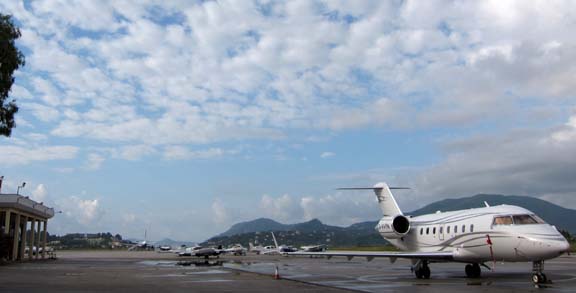
and we departed, on the OLGAT1D departure with an initial clearance to FL080. The climb path worked out just right
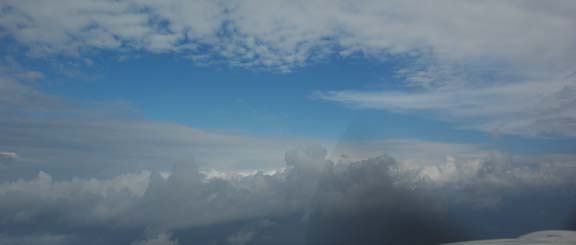
but later some IMC in cumulus could not be avoided, with strong up- and down-draughts and flying the aircraft manually to keep wings level while maintaining pitch.
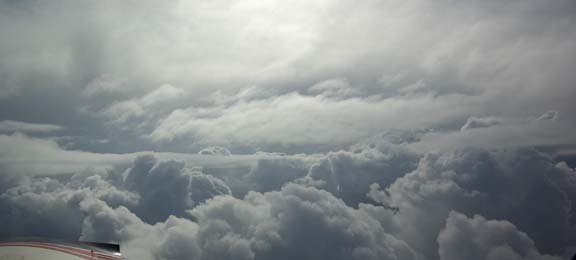
VMC was reached around FL080 - more or less as expected given the patchy cloud visible from the ground. In the warm temperatures there was no risk of icing. The next few hundred miles were flown at FL140, in VMC, on headings "to avoid weather". The next station, Tirana, was completely on the ball in perfect English and issued a clearance for any avoidance as required... every airliner on the frequency was playing the same game. There were a fair few real CBs around but they were visible from at least 100nm away
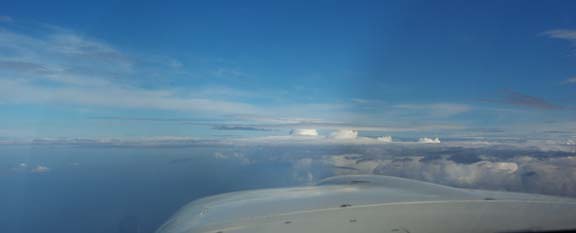
and produced good returns on the WX500 stormscope, on a generally accurate azimuth if not range
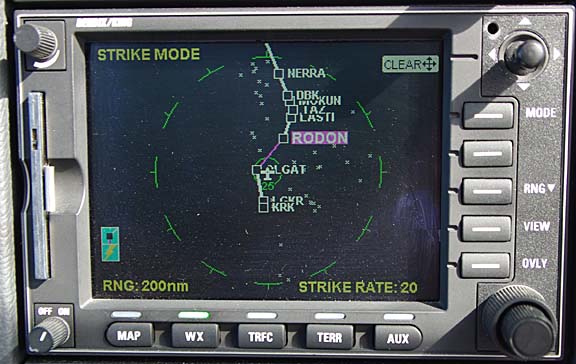
The stormscope cannot accurately measure the range; it does it primarily using the intensity of the return and this means that a particular CB will often generate strikes which line up in azimuth but are well dispersed in range - as in the above pic. A lot of spectacular weather was seen
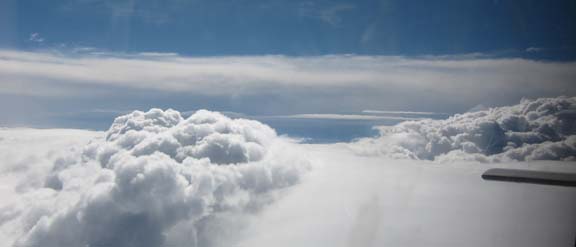
and much of Croatia was clear, with apparent cloudbases over the land of about 5000ft
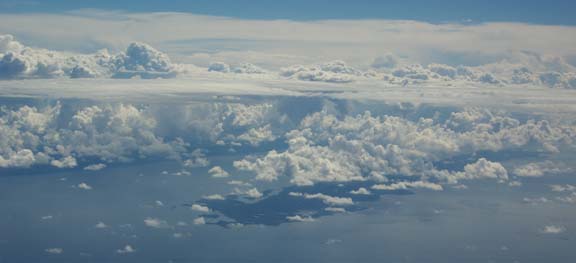
However, with about 100nm to run it was apparent that the weather near Protoroz had not cleared and there was a solid wall of TCUs (and worse) stretching from Italy to Slovenia, so the only way forward was to descend underneath it
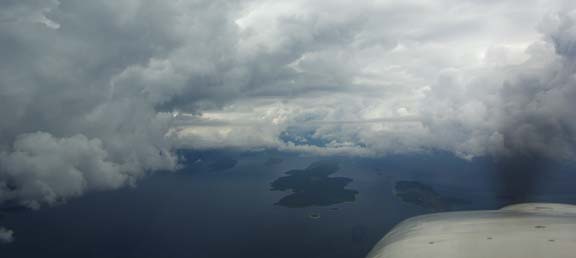
The current unit - Zadar Radar - approved everything immediately, with a descent to 3000ft. However this was not low enough and subsequent descent to 2000ft required the cancellation of IFR. The earlier rain had cleared up the haze very well
A few minutes later it became apparent that there was widespread heavy rain down below, over a wide area, and with some 100nm to go I decided to not try it, and requested a divertion to Zadar - the most northerly accessible airport and one in obviously good weather, about 15nm away. The other option was somewhere in Italy, but Croatia is far more attractive than Italy for flying, due to occassional bizzare Italian ATC behaviour and avgas selling practices... In fact Croatia is in a different league to most other places in Europe. The diversion was immediately approved, with a vector to the airport. This is the city of Zadar
and a few minutes later we were on final
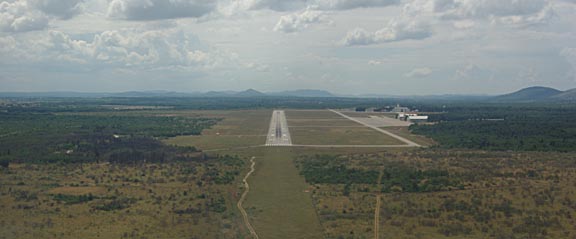
and another 10 minutes later refuelled and finished. One rarely sees anything so efficient.
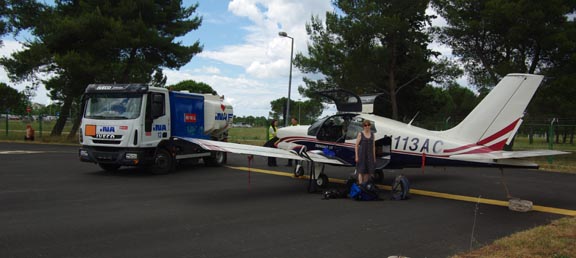
The landing FOB was 52.5USG and the fill was within 0.5% of the flowmeter-computed figure.
There was the usual upmarket hardware
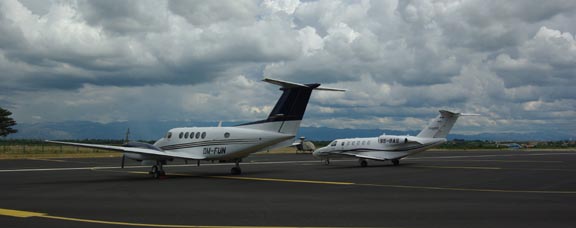
but otherwise the airport was very quiet. I get the impression that most GA - in that I include jets - movements in Croatia are visiting pilots; not locals. I hope the local scene grows because no country I have been to in southern Europe is as supportive of GA, with usable airports and reasonable airport charges, as well as the utility value of flying along such a long country, as Croatia.
We stayed at the very nice Hotel Bastion, in the old city. It was not the cheapest but by this time we had enough of hotels with duff air conditioning (2), all-night parties next door (1), rooms full of mosquitoes (3) and other stuff which prevented getting a decent sleep. It had a fast and free internet connection, using an ethernet cable.
I would highly recommended the old city for a visit
Zadar seems to reflect much of Croatia in the juxtaposition of the old communist world, and new business and financial activity
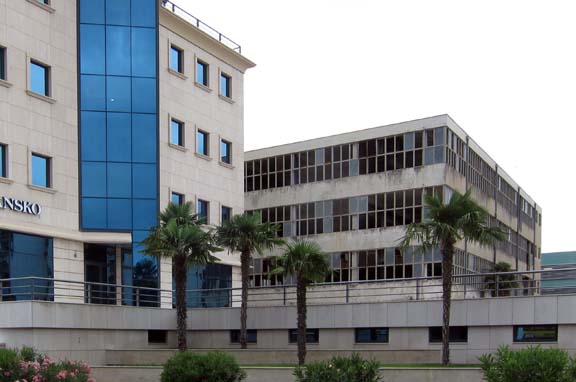
Croatia is well organised, with excellent integrated transport. In many ways it resembles Switzerland - at about 1/3 of the price!
Zadar is renowned for spectacular sunsets over the islands... however, due to the clouds, this was the best we could get
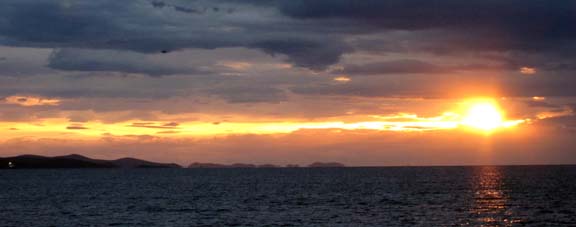
They get some "big weather" along the mountains
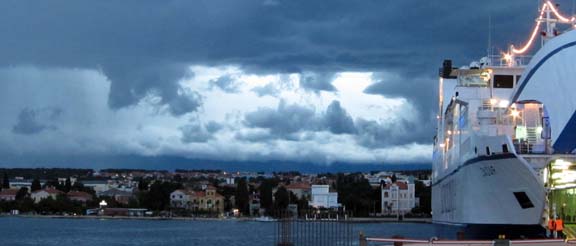
Justine's Highlights
Stay in the traffic free old town if you can manage it - with its Roman and medieval ruins, cafes and restaurants, museums and street entertainment, far more interesting than the sprawling modern city outside. This is also the ferry port and the centre for trips and excursions.
The archaeological museum (Kn 12) houses a wonderful display of finds dating from prehistoric times with some very informative English explanations. The incredible sophistication of early Adriatic culture and constant human migrations will blow your mind.
Visit a Konzum supermarket for goodies to take home, unless you want specially decorated bottles and so on in which case the tourist shops are better. We settled for Bajadera nougat, dried sour cherries and Maraska liqueurs (made in Zadar - you can see the factory just across the marina).
Sunset at the westernmost point of the old town is a must. The weather was dramatically stormy the day we did it and the experience was spectacular even so. Check out the unique 'sea organ' (musical pipes that descend into the water and create mysterious melodies) and the 'greeting to the sun' solar powered light show that comes alive as the sun disappears.
Get your bearings by taking an open-topped bus trip round the whole of Zadar
old and new. The young staff are charming, helpful, intelligent and seem genuinely
delighted to show off their fast-changing city.
Flight Zadar-Shoreham
There are two routes which are within 10 miles of each other on the distance. This one is more scenic, passing close to the French end of the Alps, and at time of writing is the one which is automatically generated by Flight Plan Pro. It has a section which must be flown at FL180 or higher
Route:
LDZD
EBITA N606 PUL P11 ROTAR L615 INBUT N503 VIC L615 OMETO/N0150F180 L615
AOSTA Z637 BANKO A1 DJL A6 ARSIL G40 VATRI B3 BILGO H20 XORBI H40 ABB T27 GURLU
Y8 WAFFU
EGKA
FL160 Distance 750nm (GC) 833nm (airways)
This one, obtained by specifying GIMIX as a fly-through waypoint in Flight Plan Pro, would avoid the stronger forecast winds over the Alps, and the trough, in the MSPL 0600 1200 charts.
Route:
LDZD
ALANU L71 GISER L862 GIMIX L608 KPT L856 HOC G4 RLP B3 BILGO H20 XORBI H40 ABB
T27 GURLU Y8 WAFFU
EGKA
FL160 Distance 750nm (GC) 842nm (airways)
We filed the latter one. I had the former one preplanned and printed back home (with a departure from Losinj LDLO, but Zadar is more or less on the same route) so used the Canon printer to generate a new set of papers for the flight.
There was an unusual last-minute problem: the above route validated OK by Eurocontrol (I normally use the EuroFPL validation site because the Eurocontrol one is super-bloated) but the filing of the flight plan produced a MAN (manual amendment) message. This normally means the route will be manually amended (by a desk operator at Brussels) which means two things: you have to wait for them to do it, and your existing documentation (enroute printouts, plog, etc) for the route needs to be re-done. This is incidentally why I never use the "reroute accepted" flight plan filing option. I waited about 10 minutes and, not having got a reply, I cancelled the flight plan and was about to re-file it when I got back the ACK message, with the original route, except for a trivial change: they inserted the name of some SID at the beginning, so the route became
ALANU1D ALANU L71 GISER L862 GIMIX L608 KPT L856 HOC G4 RLP B3 BILGO H20 XORBI H40 ABB T27 GURLU Y8 WAFFU
So I filed that and it was accepted. There are some countries which require SID/STAR names on a flight plan handed to a person at a tower, but I have not previously seen Eurocontrol reject a flight plan without them. And I have never seen a flight plan rejected which validates at the same time.
The forecast winds looked fine. TAFs and METARs looked fine too, with rain forecast at Zadar later on, so an early departure would be better. The IR image was OK and improving. The sferics image was clean. The Meteox radar image (good only N of the Alps) looked clean. For what they are worth, the 0600 and 1200 SigWx charts looked OK.
We paid for the landing and parking on the way out. The office is airside. Security was tight, with everything checked, but this seems pointless because at the end of the day they will still presumably let you out to your own aircraft! I once had my toothpaste confiscated when outbound at Norwich airport in the UK but I cannot see these people doing something so stupid. The whole process took about 30 minutes which was pretty good. Having a fully airside office is probably a good idea because it enables a "technical stop" (refuel only) to be processed without having to be escorted halfway around the airport.
The issued departure was ALANU1F (runway 32) but this was amended just before takeoff to a right turn to GISER. There was obviously not much traffic; ATC suggested we line up on the runway to do the engine checks. I hope Croatia never makes the UK mistake of privatising everything; that will result in the instant closure of most of its airports, and the exclusion of light aircraft from whatever would be left.
There was plenty of "weather" around after departure
but it was mostly avoided by flying a track about 20nm to the west of the DCT GISER one, all the way to FL160. ATC were completely relaxed.
Climbing out of Zadar we encountered a lot of turbulence, all the way to about FL100. This is mentioned on the departure plates, but I had not spotted it and anyway the winds were no more than 10-20kt. Excursions in roll were up to 30 degrees. The KFC225 autopilot, for its reliability issues, coped with this very well. Justine did not like it very much though.
Croatia has many tiny islands and 2 or 3 of them are fish-shaped
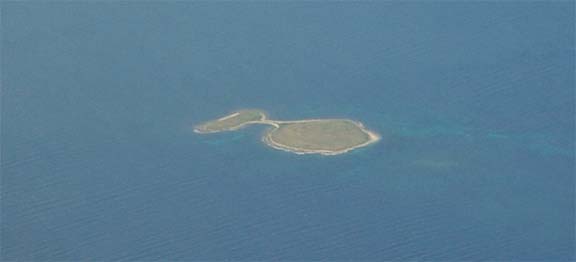
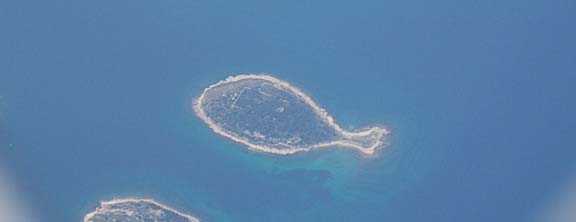
Exercising very careful engine temperature management, the TB20 takes about 30 minutes to reach FL160, by which time we were in Slovenia. One can do it quicker but there is no point. Here are the Alps
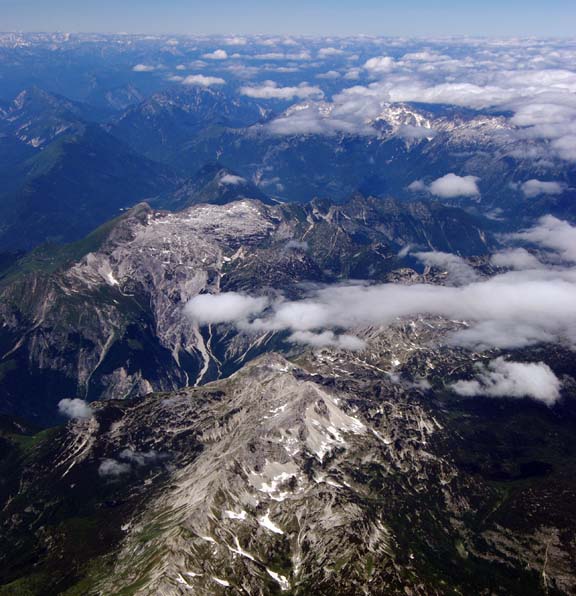
We got a series of long DCTs. Very early on, the LFOB stabilised around 22USG which I regard as very reasonable in an area where there are plenty of diversions
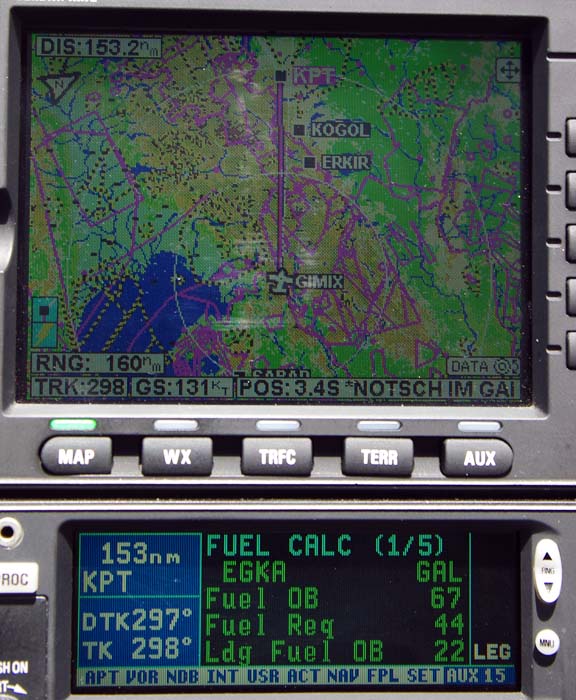
As has been the case on most of my flights in this area, the Alps were mostly under cloud
This type of flying appears hazardous but in fact the Alps have flat-bottomed canyons all over the place. How would one find one in the event of an engine failure, above an overcast? A combination of plenty of altitude, and a GPS running a map which shows the terrain:
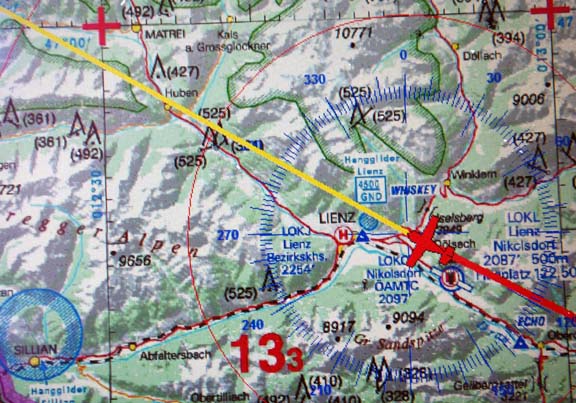
The above is a screen photo of my LS800 tablet computer running Oziexplorer which is a generic GPS moving map application, available for standard windoze, and for pocket/pc, and in this case runs various VFR and topo charts, which for this kind of usage obviously do not need to be current. I consider an overflight of the Pyrenees to be much more hazardous than an overflight of the Alps, due to the shortage of canyons in the former.
The cloud tops were around FL100-120 so a certain amount of "rock" did stick out
Here is the big stuff, photographed from at least 100nm away, with a long lens. Enhancing the image in Photoshop was difficult due to the haze, so the colours are slightly off...
The Matterhorn is visible in the above video, in the centre of the image, around 0:53.
There was no sign of the trough forecast in the MSLP charts, or any other variation whatever in the weather over that area... a ex Met Office forecaster told me once that if you put ten forecasters in a room, with the same data, they will draw the troughs in different places - or nowhere at all.
After Switzerland we had the long expanse of northern France where one really wishes one could fly at 500kt
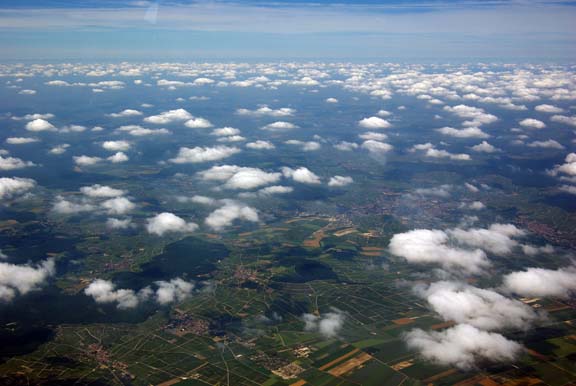
With oxygen systems, it is mandatory (to the extent that anything can really be "mandatory" on portable equipment) to carry a mask, in case somebody gets a blocked nose. On this flight, for the first time ever, we had to get the mask out for Justine, and for simplicity used it with a constant oxygen flow. On the whole trip we had used up just 3/4 of one of my two large oxygen cylinders so there was plenty of gas left. After Switzerland, I descended to FL140 and then to FL120, to reduce the oxygen requirement and to get a better speed - 150kt TAS at LOP at FL120.
To ensure a handover to London Control rather than London Information (the latter results in a loss of one's IFR clearance) I did not descent below FL120 in France. FL120+ ensures being handled by Paris Control which appears to have a letter of agreement with London Control. Due to some parachute activity, Paris Control temporarily handed us over to Lille Radar. Approaching the French coast we were transferred to London Control who gave us a DCT Shoreham - right across the Channel
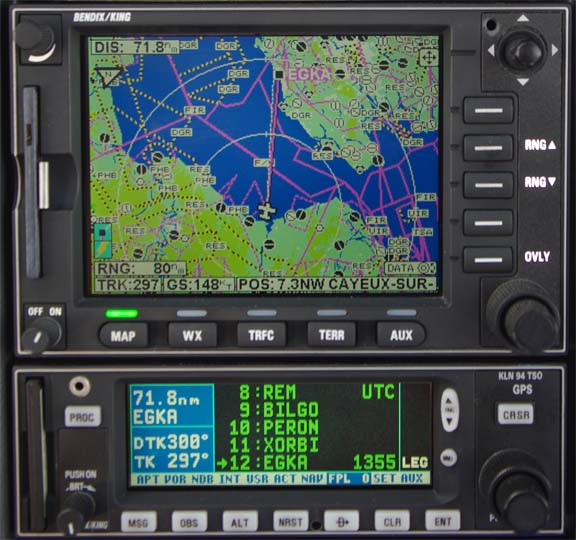
with a later descent to FL080, and then a descent out of controlled airspace. The UK was having some very good weather
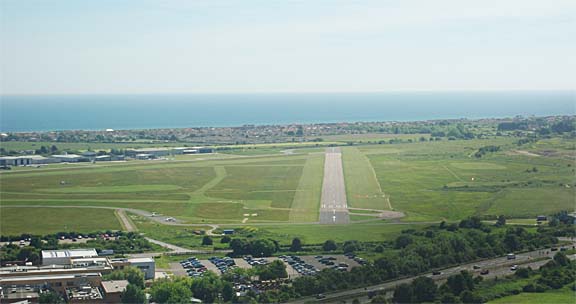
We landed with 22.3USG - amazingly close to the 22-23USG computed at the top of climb from Zadar, despite the enroute winds varying from a 10-15kt headwind most of the time to a 5kt tailwind in places.
I think the Shoreham arrivals board - look at the aircraft registration countries and their points of departure - was a pretty accurate and rather tragic picture of the result of decades of European aviation regulation.......
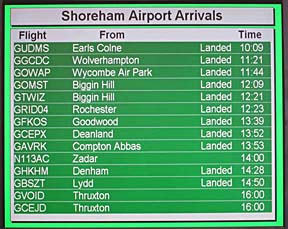
As expected, the following day's weather picture looked perfect, but the original decision to go was still correct.
Zadar-Shoreham Flight Picture Gallery
General Notes
For pilots interested in getting an IR, it is worth comparing this trip with the 2004 one which was done under VFR. With IFR, one immediately notices the huge reduction in the route planning workload. Obviously, as many traditionalists will say, "one can go anywhere VFR, using a map and a stopwatch", and I think I more or less did (in Europe) back in 2004/05 albeit 100% on GPS, but the smoothness of IFR procedures is in a different league. Even just the elimination of all controlled airspace issues, and the whole-route IFR clearance which goes together with that, takes a good 20 points off one's blood pressure :) The ground hassles which prevail in many airports do not change (and will probably get worse in northern Europe where airports tend to be highly protected bastions of 1970s British Leyland "management" practices) but once you get airborne, "all" you are up against is the weather and, almost without exception, ATC works with you to move things along. You need a suitable aircraft and the appropriate technical knowledge. The actual flights are usually totally uneventful and in good weather above the clouds; on this entire trip the total instrument time logged was about 30 minutes.
When I think back to those long VFR trips I did in 2004/2005, it is apparent that were were more lucky on the weather back then than has been the case on the IFR trips in later years...
Only three other aircraft were seen on this entire trip at anywhere near the same level - all 737-sized airliners, 10-20 miles away, and two of those were seen near Paris on the return flight. So much for "crowded European skies". The reality is that, in the FL100-FL200 airspace used by most GA, there is almost nothing there, and the Eurocontrol routings keep GA traffic away from the busy terminal areas (see the long detour around Paris on the last flight, for example).
Cloud Tops: this trip has really proven the use of IR satellite imagery, and to a lesser extent to use of sferics images, as a preflight go/no-go decider. One could achieve safe IFR flight using these alone, with TAFs and METARs for the terminal areas to check against approach minima in the usual way. MSLP charts still play a part in more general forward planning because they can be obtained 5 days ahead and show obvious suspect weather. SigWx charts have recently been dumbed-down by ICAO and no longer show fronts, or any weather in areas where CBs are forecast, and are now almost useless for this kind of non-deiced non-radar-equipped flying. On this trip we had a lot of "big weather" which I would have never departed on the basis of any forecasts; only the assurance of flyable high altitude actual conditions provided by the IR images made the flights possible.
Mobile Internet: Greece and Slovenia are in the EU but Croatia is not (with the near-meltdown of the EU, they are probably not in a hurry right now). With non-EU countries, there is the little gotcha of massive GSM roaming data charges on internet access. The recent (2009) EU directive on limiting monthly roaming data billing on GSM contract phones to 50 euros/month (unless a higher figure is agreed with the customer) has been implemented disingenuously by most mobile networks which have moved from a per-MB rate to a mandatory purchase of a "data bundle", and this is on a "per SIM card" basis so if e.g. you pick up email with a GSM-connected laptop and a phone, you have to buy two bundles (or use the phone as a bluetooth-connected modem for the laptop...). At face value, these bundles can appear good value. For example, T-Mobile sell 50MB/30-day ones for £10, which among the UK networks is probably the best deal for holiday use, which is why I am with them myself; the other reason is that they do not yet appear to have farmed out their customer service to script monkeys on the other side of the world. (Beware: the 30 day period shrinks to a near-useless 24 hours if the SIM card was purchased with one of their "laptop" USB GPRS/3G products, and a number of other networks play a similar trick). £10/50MB, at face value, is £0.20/MB which, at face value, is great. But with a legal sleigh of hand the networks wash their hands of this if the network you are connecting to is non-EU, so in Croatia the cost jumps from £0.20/MB to £7.50/MB. Croatia had excellent GSM connectivity, with fast 3G everywhere, but using this for any significant data volume is expensive. In practice, everywhere, one can try to mitigate the situation by using an email- and wifi-capable mobile phone, and checking one's email etc when an unsecured wifi access point is discovered. We found enough usable wifi networks in Greece (mostly accidentally unsecured private ones) but did not find a single one in Croatia. Update 1/2013: notes on mobile data, using local SIM cards, for Croatia and Greece, are here. A lot of this stuff is changing e.g. Vodafone, on contract, offers a "Euro Traveller" deal where your UK allowances are transferred to Europe, for £3/day, which often solves the issue completely if e.g. your contract gives you 250MB/month free data.
PPR: This remains one of the biggest issues on long trips around Europe, and is not getting any better. "PPR/PNR for Customs" is more common still. A local-language speaker can bluff his way into most places, but a foreigner is likely to be denied a landing clearance in some places, perhaps especially if flying a US registered aircraft. On this trip, I found that concurrently emailing and faxing an airport, with the body of the message containing one's email and fax number, worked quite well. I do this by emailing, and BCCing the email to my email2fax account. More often than not, the email bounces back (invalid) but the fax is delivered, and if I don't get a reply within a day I just re-send the fax. In an urgent situation one would try phoning the airport and while this is fine in N Europe and some other places, I know of cases (Greece) where a telephoned permission turned out to be worthless. Airport management is only beginning to discover email so a receiving fax number is essential - I use Inweb for a fax-to-email service with a normal geographic (not 0870 etc) UK fax number. A reasonably good source of airport fax numbers is the ACUKWIK airport directory; another one is Navbox. One would expect the AFPEx tool (available only to pilots with a UK address) to work well, using its AFTN free text message function, but I have found that most messages do not elicit a reply. Interestingly, Sitia in Crete did reply to my AFTN message, but they replied by email... you just never know your luck!
IFR route development: FlightPlanPro worked out every route perfectly. It is great to see that one can finally fly IFR without having to read standard route documents and all the associated stuff which, even if one understood it perfectly, still doesn't guarantee that a route will be accepted by the computer in Brussels.
Flight Times (airborne):
EGKA-LDLO 6:00
LDLO-LGST 5:40
LGST-MESSI 2:50
MESSI-LGKR 0:45
LGKR-LDZD 2:45
LDZD-EGKA 5:55
Here is the track actually flown on the entire trip, as recorded by Oziexplorer.
The aircraft performed perfectly. Some notes on Socata TB20 ownership and operation are here. As on every IFR flight I have done, the late-1990s avionics were 100% capable of everything required. Total oil used was 2 litres.
I would like to give my thanks to my Greek friends, particularly Kyprianos Biris and Giannis Georgantakis, for their invaluable assistance on this trip.
Photos: The pictures in this writeup were taken with a Pentax K200D and a Canon S90. The images within the text were cropped and adjusted in Photoshop, but the images in the galleries are mostly original. To get acceptable pictures from an aircraft, the windows need to be clean and scratch-free and care needs to be taken to minimise reflections from bright objects inside the cockpit; these may need to be temporarily moved or re-orientated. For example I usually have to turn my kneeboard upside down. The camera lens should be held very close to the window - but do not actually touch the window with any part of the camera otherwise vibration is transmitted to the camera. Touching the window with one finger of the hand which is holding the camera is an effective technique which also stabilises the camera. Forward-looking pictures without a propeller blade showing are almost impossible with a 3-blade propeller unless one either takes dozens of them and gets lucky, or uses a slow shutter speed of 1/125 or slower but that impacts sharpness.
Pilot: FAA CPL/IR, approx 1200 hours (at the time).
This page last edited 29th January 2013
Any feedback, reports of dead links, corrections or suggestions much appreciated: